Create successful ePaper yourself
Turn your PDF publications into a flip-book with our unique Google optimized e-Paper software.
History of Men’s Handball World Championships<br />
<strong>Part</strong> I <strong>1938</strong> – 1960<br />
The first indoor handball world<br />
championship in <strong>1938</strong> lasted only two days,<br />
which is not surprising, as only four<br />
countries were participating. On 5 and 6<br />
February <strong>1938</strong>, host Germany, Austria,<br />
Sweden and Denmark, under the direction<br />
of the International Amateur Handball<br />
Federation (IAHF) – the predecessor of the<br />
International Handball Federation (<strong>IHF</strong>) –<br />
determined the winners of the round-robin<br />
tournament, which thus didn’t have a real<br />
final. The Germans narrowly defeated<br />
Austria in the “final” 5:4. Sweden beat<br />
Denmark 2:1, which was enough to win the<br />
bronze medal.<br />
However, indoor handball played a rather<br />
minor part in the first half of 20 th century.<br />
In fact, outdoor handball prevailed. In<br />
1936, the Germans had won the Olympic<br />
gold medal at the premiere of outdoor<br />
handball in Berlin. Coach Otto Kaudynia<br />
led them to the victory at the WCh premiere<br />
as well, which was also organized by the IAHF. In the final, they celebrated an<br />
emphatic 23:0 victory over Switzerland. The team of the world champion included
some players who had also won the gold medal at the Olympics in Berlin and the<br />
indoor handball WCh, just like their coach. Austria didn’t participate in the WCh, as<br />
National Socialist Germany led by Hitler had annexed the Alpine republic in March<br />
<strong>1938</strong> (“annexation of Austria”).<br />
The tournament mode of the event which<br />
had 10 participating teams was unusual:<br />
The matches were played in the knock-out<br />
system. Three of the five teams, which had<br />
won their first matches, reached the semifinal.<br />
Sweden and Romania, who had also<br />
won their opening matches, had to play in a<br />
so-called intermediary round, which was<br />
won by Sweden who became the fourth<br />
semi-finalist. Romania came in fifth. In the<br />
semi-finals of the four-day competition,<br />
Germany defeated Hungary, whereas<br />
Switzerland prevailed against the<br />
Scandinavians who also lost the bronze final<br />
against Hungary.<br />
Due to World War II which started in 1939<br />
and the consequences of the war, it was not<br />
until 1948 that world championships could<br />
be organized again.<br />
It was the first time that the outdoor world<br />
championship took place under the<br />
direction of the International Handball<br />
Federation (<strong>IHF</strong>) founded in 1946 – this<br />
hasn’t changed until now. France had agreed to host the championship. Germany<br />
didn’t participate, as the country was governed by the victorious powers of World<br />
War II and didn’t have its own national federation – in addition, several international<br />
organizations didn’t allow competing with the nation that caused the war at sport<br />
events. Twelve teams participated in the WCh; eight of them played a preliminary<br />
round whose winners reached the quarter-finals, in which they played against four<br />
seeded teams. Sweden, Switzerland, host France and Denmark reached the semifinals,<br />
in which both Scandinavian countries could prevail. Sweden clearly won the<br />
final against Denmark 11:4 and secured their first (and only) world championship<br />
title in outdoor handball.<br />
Four years later, the 3 rd outdoor handball WCh was held in Switzerland. 13 teams<br />
competed in this event – they were all from Europe, as already at the previous<br />
championship. The Saarland had its own team, whereas Italy and Portugal didn’t take<br />
part. The qualification was followed by a preliminary and an intermediary round in<br />
the knock-out system as well as three placement matches for the places 1 to 6 at the<br />
end of the tournament. Germany, represented by a DHB selection of the Federal<br />
Republic, and title holder Sweden met in the final, in which Germany clearly defeated<br />
Sweden 19:8 and won the title.
Two years later at the indoor WCh, the “Tre Kronors” were all the more successful.<br />
Whereas outdoor handball was still more popular in Central Europe in the 50ies,<br />
indoor handball more and more prevailed in Scandinavia. It was therefore almost<br />
logical that Sweden didn’t only host the 2 nd indoor world championship in 1954 after<br />
a 16-year break, but also achieved to win this tournament. Six teams had announced<br />
their participation in the event, which took place from 13 to 17 January, also<br />
including the divided Germany with a joint team of DHB (FRG) and DHV (GDR). The<br />
Germans won their preliminary round matches against Switzerland and France,<br />
whereas Sweden defeated Denmark and Czechoslovakia. The host won the final 17:14<br />
(8:5) and CSSR took bronze.<br />
The next outdoor handball WCh was held only one year later – this time hosted by<br />
Germany. A record was broken, as 17 countries participated in this WCh. The teams<br />
played in six preliminary round groups and afterwards in two intermediary rounds.<br />
The winners of the intermediary round reached the final. The Germans, also<br />
benefiting from home advantage, celebrated their next victory – this time over the<br />
Swiss, who were without a chance against the DHB selection (25:13).<br />
The other part of Germany, the GDR, organized the 3 rd indoor handball WCh in 1958.<br />
The fast game in the hall also prevailed more and more in the German-speaking<br />
countries in Europe. Brazil was the first non-European country in handball history to<br />
participate in a WCh. The host took part with an all-German team – as already in<br />
1954 (and again in 1961). Winning 46:4 in 1958, the Germans also celebrated the<br />
highest victory ever in WCh history. They however failed to reach the final after their<br />
defeat against Czechoslovakia in the intermediary round. In the final, the East<br />
Europeans didn’t have the slightest chance against title holder Sweden either – the<br />
Swedes clearly won 22:12.
Another WCh took place in the 50ies of the last century: the outdoor handball WCh<br />
1959 in Austria. After the record participation in 1955 (17 nations), only nine<br />
countries competed for the world championship title at that time. Belgium, France<br />
and Yugoslavia didn’t take part. The end result was as usual, given that the Germans<br />
are participating – they became world champions. This time, the all-German team<br />
beat Denmark and Sweden in the preliminary round and Romania in the final (14:11).




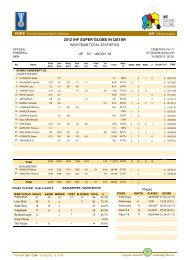

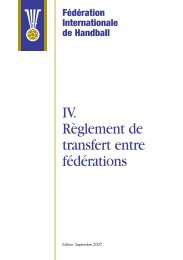
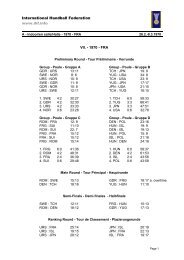


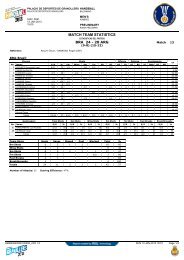

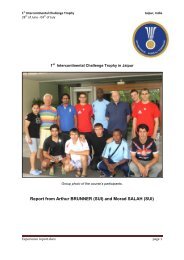
![[IHF- Referee list 2012/2013]](https://img.yumpu.com/18217761/1/184x260/ihf-referee-list-2012-2013.jpg?quality=85)


